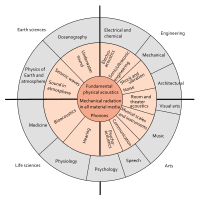
Photo from wikipedia
Abstract Vibration response has been extensively used for fault diagnosis, condition monitoring and root cause analysis of issues in the smooth operation of mechanical systems. In recent years, acoustic emission… Click to show full abstract
Abstract Vibration response has been extensively used for fault diagnosis, condition monitoring and root cause analysis of issues in the smooth operation of mechanical systems. In recent years, acoustic emission (AE) measurement and analysis have found significant applications in the field of in-situ as well as off-site fault diagnosis and condition monitoring of machines. To monitor vibration or AE of system, sensors are placed close to rolling element bearing (REB), but in fact, REBs themselves are sometimes the source of the problem in the machinery. As such, in all the dynamic mechanical systems, REBs are one of the most critical components, in regards to their usefulness as well as failure. This has led to extensive analytical and experimental research on REBs. To study the dynamic features and inherent characteristics of REBs, many researchers have formulated multi-body dynamic models of REBs. The results of these models have been well supported by experimental evidence. Contrary to this, very few attempts can be located in literature, which aim at modelling of acoustic emission of REBs and hence this paper is tasked with the same. A novel approach for AE modelling is used in this paper, and the proposed model is a blend of multi-body dynamic model and asperity based acoustic emission model of REB. The dynamic model of REB is solved to compute the contact deformations and thus contact forces. From these contact forces and lubricant film thickness; asperity forces and their deformations are computed and then fused into the AE model to compute the root mean square (rms) value of resultant AE signal. The developed model is deployed for analyzing the effect of load, speed, and radial clearance on AE. The results show that AE increases as load increases, it increases as speed increases up to a certain value and then decreases, and finally, as clearance increases, the AE decreases.
Journal Title: Journal of Sound and Vibration
Year Published: 2020
Link to full text (if available)
Share on Social Media: Sign Up to like & get
recommendations!